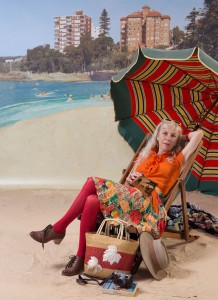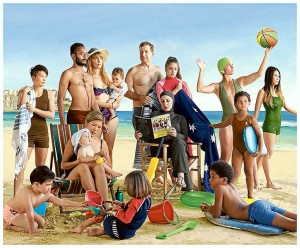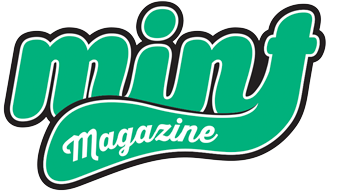By ANDREA LOUISE THOMAS
 Sydney photomedia artist, Anne Zahalka has created iconic images of the ever-changing face of Australian culture over the past two and a half decades. Her work explores issues of national identity, gender, multiculturalism and cultural stereotypes with critical insight, good humour and spectacular technique. She’s represented in all of Australia’s national galleries and in international collections. Her explorations of Australian leisure pursuits and beach culture are some of her most recognized subjects.
Sydney photomedia artist, Anne Zahalka has created iconic images of the ever-changing face of Australian culture over the past two and a half decades. Her work explores issues of national identity, gender, multiculturalism and cultural stereotypes with critical insight, good humour and spectacular technique. She’s represented in all of Australia’s national galleries and in international collections. Her explorations of Australian leisure pursuits and beach culture are some of her most recognized subjects.
MINT: Where and when did your passion for photography begin?
ZAHALKA: At art school I was introduced to a whole range of media but loved the magic and immediacy of photography. When I started studying photography more seriously, I began working with images in a very constructed way. While I was interested in taking photographs that captured things in the real world, I was also interested in trying to create my own world through images.
MINT: What’s the difference between photography and photo media?
ZAHALKA: Photography is working in a traditional way from a specific body of knowledge and history. Photo media is work developed across a range of photo-based technologies including movies and other film or digital media in a more expanded and conceptual way.
MINT: Since shooting The Bathers in 1989 what do you find most different at the beach today?
ZAHALKA: I think there’s a lot more ethnic and cultural diversity. In 1989 it was a lot more European and Anglo rather than Asian, Latin American, African or Middle Eastern. In making the New Bathers (2013) I wanted to create something that commented on these changes and the different make up of this beach scene – trying to reflect a combination of characters to tease out new meanings and challenge some of the old ideas and stereotypes.
MINT: The beach features significantly in your work. Why is that?
 ZAHALKA: I’m interested in the way the beach has come to define us and how it has been represented and to look behind the façade of the bronzed Aussie and portray those others who don’t figure as prominently in this picture and give voice to those groups.
ZAHALKA: I’m interested in the way the beach has come to define us and how it has been represented and to look behind the façade of the bronzed Aussie and portray those others who don’t figure as prominently in this picture and give voice to those groups.
MINT: Do you think photography allows greater or lesser scope for social and political commentary than other art forms?
ZAHALKA: Greater in many ways because it’s a visual language that everybody understands. In photography you’re working with a realism that painting and sculpture have to create. Part of the way I work is to conceptualize and plan my images and build different layers into them. These more constructed works are very much a way of speaking about something sociological or political that is current.
MINT: What Australian social or political issues interest you the most now?
ZAHALKA: I am very concerned about the demonising of Muslims. I find any kind of racism abhorrent. I’m particularly bothered by the treatment of refugees and the brutal policies of putting people in detention. Our treatment of our Indigenous people is shocking and disgraceful. It’s difficult to understand. My work attempts to give people from different backgrounds a voice by making my work more inclusive and allowing for this diversity to be reflected. Coming from a migrant family who were refugees makes me even more sympathetic to their plight.
MINT: How would you characterize our national identity?
ZAHALKA: We are a nation made up of a multitude of different identities and the figure of the Aussie that doesn’t quite fit that. Working on projects such as Welcome to Sydney (2002) introduced me to a very diverse group of people from a variety of migrant backgrounds and areas of Sydney that I hadn’t known. With so many culturally distinct communities living here our national identity is less simply characterized which I think is a good thing.
MINT: What would you most like to be remembered for?
ZAHALKA: I feel very fortunate to have forged a career as an artist. I think I’ve made work that has responded to at a particular moment with a contemporary medium that people relate to. These kinds of images dealing with Australian history and culture resonated with audiences. Today my work is being studied and collected! I already feel I have left a mark.
See Zahalka’s The Bathers in On the Beach at Mornington Peninsula Regional Gallery from December 11 to February 28, 2016. MPRG, Civic Reserve, Mornington.
Ph. 5975 4395


